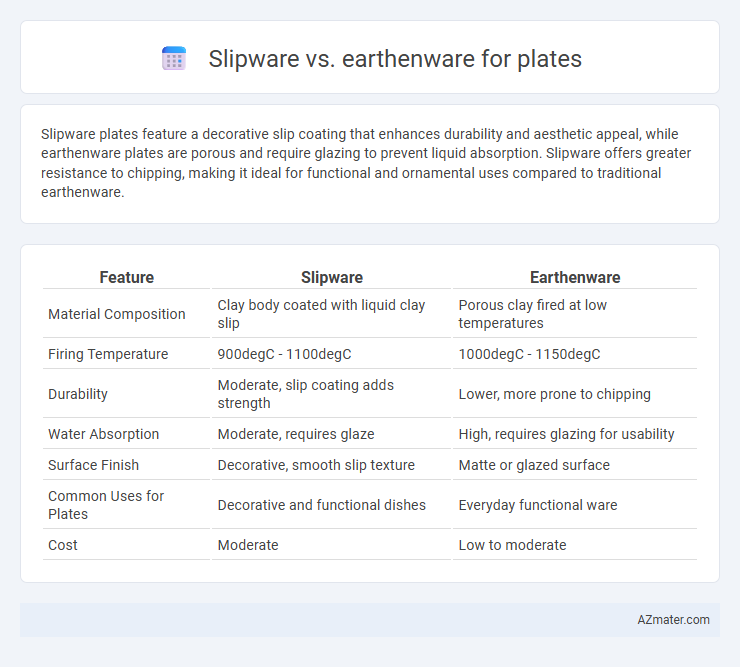Slipware plates feature a decorative slip coating that enhances durability and aesthetic appeal, while earthenware plates are porous and require glazing to prevent liquid absorption. Slipware offers greater resistance to chipping, making it ideal for functional and ornamental uses compared to traditional earthenware.
Table of Comparison
| Feature | Slipware | Earthenware |
|---|---|---|
| Material Composition | Clay body coated with liquid clay slip | Porous clay fired at low temperatures |
| Firing Temperature | 900degC - 1100degC | 1000degC - 1150degC |
| Durability | Moderate, slip coating adds strength | Lower, more prone to chipping |
| Water Absorption | Moderate, requires glaze | High, requires glazing for usability |
| Surface Finish | Decorative, smooth slip texture | Matte or glazed surface |
| Common Uses for Plates | Decorative and functional dishes | Everyday functional ware |
| Cost | Moderate | Low to moderate |
Understanding Slipware and Earthenware
Slipware plates are crafted by applying a liquid clay slip onto earthenware bodies, creating decorative finishes and enhanced durability. Earthenware is a porous, low-fired ceramic material that forms the base for slipware and is characterized by its warm, earthy tones. Understanding the interplay between slipware and earthenware helps appreciate the artistic techniques and functional qualities of handmade ceramic plates.
Historical Background of Slipware and Earthenware
Slipware, with origins tracing back to the Neolithic period, was widely used in ancient civilizations such as Mesopotamia and the Indus Valley, characterized by its decorative slip coating applied over earthenware bodies. Earthenware, one of the oldest pottery forms dating back over 10,000 years, was primarily utilized for utilitarian vessels due to its porous nature and lower firing temperatures compared to stoneware and porcelain. Both types played significant roles across cultures for everyday use and artistic expression, with slipware evolving through techniques that enhanced aesthetic appeal while earthenware maintained its functional significance.
Key Differences in Materials and Composition
Slipware plates are crafted using clay coated with a liquid clay mixture called slip, which allows decorative techniques and a smoother surface finish, often incorporating iron or manganese oxides for color variation. Earthenware plates, made from porous, fired clay containing natural impurities like quartz and feldspar, typically feature a glaze to create a non-porous surface and are characterized by their softer, more absorbent body compared to slipware. The key difference lies in slipware's decorative slip coating applied before firing, enhancing both aesthetics and texture, whereas earthenware relies on glaze application post-shaping for durability and waterproofing.
Production Techniques: Slipware vs Earthenware
Slipware plates are created by applying a liquid clay mixture called slip onto a leather-hard earthenware body, allowing for intricate decorative patterns before firing, while earthenware plates are formed from naturally porous clay that is shaped, dried, and fired without added slip layers. Slipware production relies heavily on the controlled application of colored slips to create vibrant designs, enhancing both aesthetics and surface texture. Earthenware production emphasizes the clay's natural properties, typically resulting in simpler, unglazed or glazed finishes, with a focus on durability rather than decoration.
Design and Decorative Possibilities
Slipware plates feature intricate designs achieved through the application of colored slip, allowing for detailed patterns and textured surfaces that enhance visual and tactile appeal. Earthenware plates, with their porous clay body, offer a versatile canvas for glazing techniques that produce vibrant colors and glossy finishes, often showcasing traditional or rustic motifs. The design flexibility in slipware emphasizes craftsmanship and layered decoration, while earthenware excels in color variety and surface shine, catering to diverse aesthetic preferences.
Durability and Functional Performance
Slipware plates feature a protective slip coating that enhances resistance to scratches and stains, making them more durable compared to traditional earthenware. Earthenware plates, while porous and less resilient to impacts, offer excellent heat retention and are generally lighter, contributing to functional performance in casual dining. Both materials require careful handling to prevent chipping, but slipware's glaze provides an added layer of strength and longevity in everyday use.
Aesthetics: Colors, Textures, and Finishes
Slipware plates showcase intricate surface designs achieved by applying colored liquid clay slips, resulting in vibrant patterns and layered textures that enhance visual depth. Earthenware plates offer rustic charm with a broader range of natural earth-toned hues and matte or glossy finishes that emphasize organic textures and earthy appeal. The choice between slipware and earthenware impacts the plate's aesthetic versatility, where slipware emphasizes artistic decoration while earthenware highlights natural material beauty.
Suitability for Everyday Use
Slipware plates, coated with a layer of liquid clay slip, offer durability and resistance to chipping, making them suitable for everyday use. Earthenware plates, fired at lower temperatures, tend to be more porous and fragile, requiring careful handling and often a glaze to prevent stains and moisture absorption. For daily dining, slipware provides a more robust option due to its enhanced strength and decorative appeal.
Price and Market Availability
Slipware plates are often more affordable due to simpler decorative techniques involving liquid clay slip, making them accessible in artisan markets and local pottery shops. Earthenware plates, typically glazed and fired at lower temperatures, have wider market availability in both budget and mid-range segments, offered by mass producers and handcrafted potteries. Price differences reflect production methods and durability, with earthenware generally commanding higher retail prices due to its finish and variety.
Choosing the Right Plate: Slipware or Earthenware
Slipware plates feature a decorative slip coating that enhances their aesthetic appeal and adds a slightly textured surface, making them ideal for artisanal dining experiences and rustic table settings. Earthenware plates, composed of porous clay fired at lower temperatures, offer durability and affordability but require glazing to ensure they are food-safe and moisture-resistant. Selecting between slipware and earthenware plates depends on balancing visual appeal with functional needs such as durability, ease of cleaning, and the intended use in everyday or special occasion settings.

Infographic: Slipware vs Earthenware for Plate
 azmater.com
azmater.com